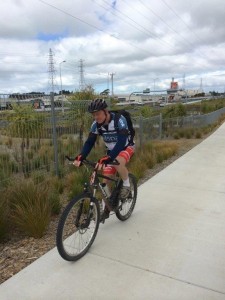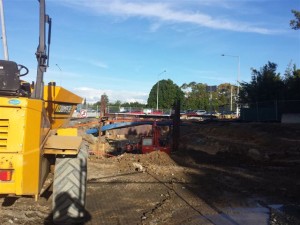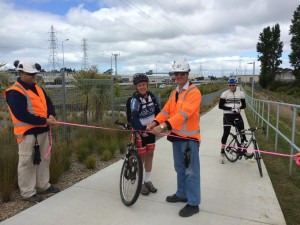
If you’ve used any of the cycleways out west, chances are you owe a debt to Phil Robinson – although he’d be the first to downplay his influence. He’s a modest chap, but over the past few years he has built up a casual but powerfully positive relationship with the people who build cycle infrastructure.
Phil’s approach is friendly and open-minded. He’ll stop, chat, observe and compliment the work – and then ask a question or make a suggestion about some small detail that could make a big difference. The camber. The hardware. The placement of the cones. Whether the resting bars are in the right spot. Staging the work so that commuters can carry on through. Quick detours on quiet streets, instead of roundabout routes via busy roads.
“These are the sorts of little wins we can get on most medium-sized jobs.” Tiny things, but huge for riders.
Phil wouldn’t call himself anything as formal as a consultant – “I just ask questions. I enjoy the informality of the relationship. I just think of it as helping everyone” – but he’s a great person to have as our eyes on the street.
And there’s a depth of experience behind those eyes. Phil’s seen biking in Auckland through several phases. “I rode in high school, in the early 70s, at the beginning of the 10-speed revolution. The second revolution was the latter half of the 80s, with the fat-tired bikes, which were comfortable and had more speeds – although I missed most of that as I was raising a young family. And more recently, you’ve got the boom in commuter cycling, which I’m a daily part of again.”
As a university student, says Phil, “I cycled everywhere.” He was a member of the University Bicycle Club, which came under the umbrella of the Auckland Bicycle Association (a “group of groups” that also counted Friends of the Earth among its friends). Its legacy is a book about cycle routes around Auckland, now stashed in the National Library archive. “A historical document!’
The University Bicycle Club also campaigned to allow bikes on ferries, trains, and buses (hey, two out of three ain’t bad). And there was another pioneering effort too, that Phil typically downplays.
“We biked the bridge, one time.”
What? Yes, they got across the Harbour Bridge – in the 70s – before it was cool. (Dads really are the original hipsters). “There were about 18-20 of us. I don’t think it was widely publicised in the papers, probably because they didn’t want to encourage it. But we did it.”
Tragically, a friend of Phil’s was killed on Symonds St biking to university, after which the club led an urgent push for proper cycle lanes up Symonds Street and out along New North Rd. A moment of silence while that sinks in. Four decades on, how far have we come?
Sometimes, he says, it seems “the people have changed, but the story’s the same.” He’s an optimist but he does admit to a bit of frustration with “the cyclic nature of things” (no pun intended). Still, he points to a steepening curve over the last decade as the official philosophy has changed from simply encouraging people to get out on bikes, to actually delivering (finally!) real infrastructure for people on bikes.
“I come from the northwest, so we’ve had the luxury of the Northwestern Cycleway. That’s been a great thing. First it was built strictly as a cycleway – no pedestrians – from town to Te Atatu. Then it was redesignated as a shared path, because people clearly wanted to use it for walking too.”

As a commuter, Phil bikes up Te Atatu Rd to The Concourse, so he knows those roads well. At the moment, he’s keeping an eye on transformations where Te Atatu Rd meets the motorway; and around Lincoln Rd, Central Park and Don Buck Rd; plus Rosebank Rd and Patiki Rd.
“They are listening,” he says of Auckland Transport and NZTA. “And they’re becoming more approachable as they realise we’re not, you know, fanatical.” A lot of which probably has to do with Phil’s low-key, generous, helpful approach.
As well as doing long weekend or night rides across the city with friends and family, Phil races mountain bikes. The irony is, plenty of the people he sees out on the trails absolutely love riding… but are scared to ride in the city. He, on the other hand, enjoys taking his grunty workhorse of a fat-tired bike pretty much anywhere it will go. “I have a road bike, too, but this one gets me off the road, even in the city. There are all these greenstrips that connect the city in all different ways. Sometimes it’s just me and the council mowers.”
Hence his enthusiasm about the Whau West Greenway project, which will link the Waitemata to the Manukau via riverside parks and hidden byways. “It’s such a beautiful ride on a Sunday morning. I know where all the links could be, so I’m keen to help connect all the players.” (Much of the project falls under Parks and Reserves, with Auckland Transport’s help at both ends and in the middle. It’ll be a fantastic showcase and a corridor opening up a large swathe of the West, as you can see from the flyover below).
Joining things together is the trick, especially when it comes to connecting NZTA projects with AT projects. At Lincoln Rd, for example, there’s still a gap where work needs to go “not even the extra mile – it’s just 40m, a no-man’s land between where one path ends and the other begins.” He hopes the connection will be smoother at Te Atatu. “It should be simple to just join the dots.”
Ideally, says Phil, those in charge of constructing cycle infrastructure could “talk to us earlier, so they could build our bike philosophies in at the design stage, rather than the fixing stage.” Which is why people who know the area like the back of their hands are so crucial, at every step of the process. “We need people prepared to drop by on these things every day,” he says. “Local champ” is a title he’s happy to accept.
What advice would he offer for those who’d like to take on such a role in their neighbourhood?
“Show up. Make yourself useful. Go along to the liaison meetings, and just keep showing up. You’ll find you can steer people informally towards sensible solutions. It helps to have negotiating skills, plus a vague clue of what will work and what won’t.” And always give credit where it’s due. “These guys are good at their job. And people get a buzz out of being told they’ve done something right.”
Above all, it’s about being there. “Being there makes so much difference. Sometimes they can’t fix it – but sometimes they can.”
Local champs like Phil are a crucial part of making Auckland better for people on bikes. Cycle Action would love to be everywhere at once, but we really need eyes on the ground all over town. Which is where you come in. If you’re keen to help in your ‘hood, we’ll happily support you. Get in touch and let us know where you’d like to make a local difference!





